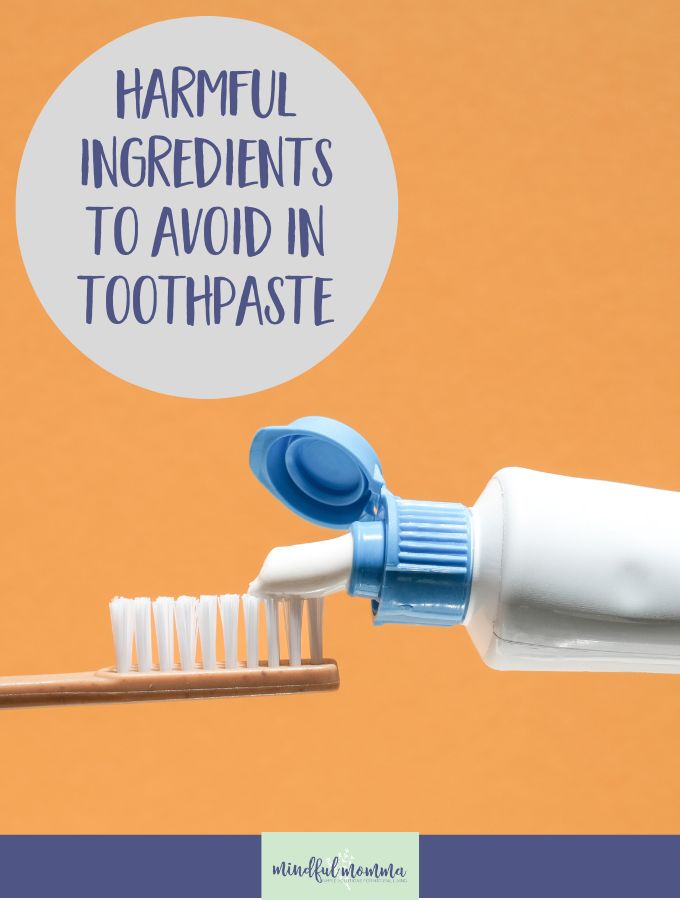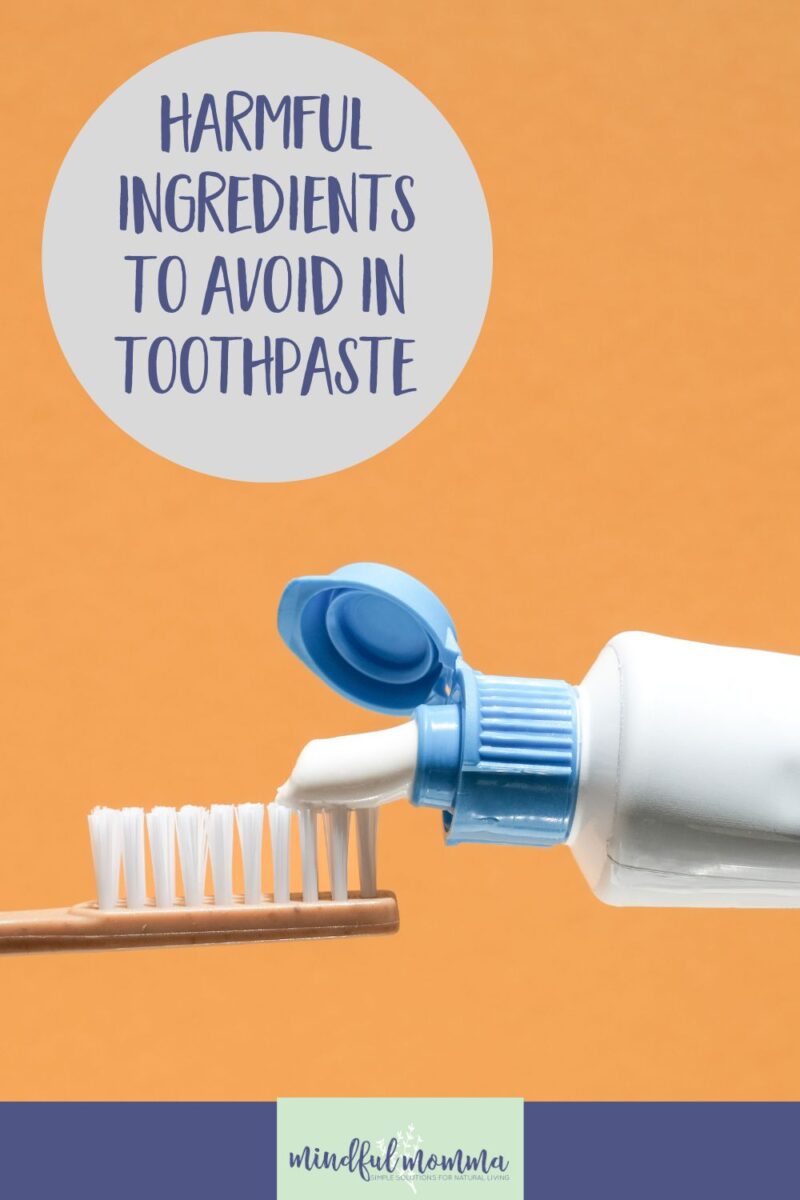Toothpaste Ingredients to Avoid for Better Oral Health
Learn which harmful toothpaste ingredients to avoid in order to keep your teeth looking their best and to ensure good oral health for the long run.

Brushing our teeth is one of those daily habits that is easy to take care of without much thought. And that’s good because our dental health is very important!
BUT….just as we scrutinize the labels of our food and personal care products, understanding the ingredients in the toothpaste we use is key to ensuring our best oral health for the long run.
Note: There may be affiliate links in this post including Amazon Affiliates. Full disclosure.

I may receive commissions from purchases made through links in this article including Amazon Affiliates. Full Disclosure
Toothpaste Ingredients to Avoid
It’s important to be aware that certain ingredients in toothpaste should be avoided in order to prioritize your oral health. Some ingredients, like triclosan, fluoride, and sodium lauryl sulfate, have raised concerns due to their potential negative effects. Triclosan, for example, has been linked to hormone disruption, while fluoride in excessive amounts can cause fluorosis. Sodium lauryl sulfate, which is used to create foam in toothpaste, may irritate the gums and cause mouth sores in some people.
In light of these concerns, I’ve done the research to help you understand which toothpaste ingredients to AVOID in order to keep your pearly whites looking their best, without compromising your health.
Reasons to Reconsider Fluoride
We’ve long been schooled on the benefits of fluoride for preventing tooth decay and it is strongly backed by the American Dental Association for its ability to strengthen tooth enamel. But have you ever stopped to consider the flip side of this common toothpaste ingredient?
Research has unearthed some concerning findings that are cause for reevaluation. Fluoride, while championed for its cavity-fighting prowess, has been linked to neurological and endocrine dysfunction (notably in children), casting a shadow over its previously untarnished reputation. Additionally, excessive exposure to fluoride can lead to a condition known as fluorosis, manifesting as discolored spots on teeth.
As conscious consumers, it’s important to sift through these findings and consider the pros and cons of fluoride use. Whether or not to use fluoride toothpastes is a personal choice that will be different for each of us.
The Trouble with Sodium Lauryl Sulfate (SLS)
Known for its foaming prowess, SLS is more than just a bubble-maker. It’s a double-edged sword that, while helping your toothpaste clean better, might be doing more harm than good. Over the years, this ingredient has been linked to skin irritation and a heightened risk of canker sores or mouth ulcers when used in large amounts.
This certainly makes me question its presence in oral care products meant to promote dental health. If you’re someone with sensitive skin or sensitive teeth, you may want to avoid toothpastes with SLS altogether. Fortunately, there are plenty of SLS-free toothpastes available these days.
Triclosan: More Harm Than Good?
Triclosan is an ingredient known for its antibacterial properties and was commonly used in personal care products, until studies linked it to hormone disruption. While triclosan was banned from hand soaps and body washes in 2017, it is still legally allowed in toothpaste. That said, most manufacturers of toothpaste in the United States have discontinued the use of triclosan in their products. My advice is to always check the toothpaste ingredients list for triclosan, especially when purchasing from discount stores or dollar stores, where products may have been imported from other countries.

Steering Clear of Artificial Sweeteners & Colors
When you’re scanning labels for toothpaste ingredients, it’s easy to gloss over familiar terms like artificial sweeteners and colors, thinking they’re just there to make the brushing experience a bit more pleasant. But, it’s important to note that these sweet additives can have a bitter side.
While artificial sweeteners don’t contribute directly to tooth decay, their long-term effects on our health are still a hot topic for debate. Instead, natural ingredients like xylitol, stevia, or erythritol not only offer the sweetness we crave but do so without the shadow of health issues.
Artificial colors and sparkles in toothpaste might give it an enticing hue, but it’s worth considering whether these additives serve any real benefit. While they may make the toothpaste visually appealing, they don’t contribute to its effectiveness in cleaning or protecting your teeth. In fact, some artificial colors may contain chemicals that could potentially cause irritation or allergic reactions for some individuals. Choosing toothpaste without artificial colors and sweeteners ensures that you’re prioritizing your oral health without unnecessary additives.
Parabens: A Preservative with Consequences
Parabens are commonly used to preserve the shelf life of many cosmetic products, including toothpaste. These chemicals have been shown in several studies to mimic estrogen in the body, a process which can lead to endocrine disruption. Given the fact that parabens have links to breast cancer and reproductive issues, it’s best to steer clear of toothpaste that contains this preservative.
Diethanolamine (DEA): A Toxic Reaction
DEA, a common ingredient aimed to provide foamy lather in products, has been under scrutiny for its potential link to hormone disruption and various types of cancer. The mechanism is thought to involve DEA reacting with other ingredients to form nitrosamines, which are known to be absorbed through the skin and have been classified as a probable human carcinogen.

Natural Toothpaste Alternatives
As you work towards making the switch to safer personal care products, it’s time to shift your focus to toothpastes that are formulated with effective, natural ingredients, while steering clear of potentially harmful chemicals like triclosan, sodium lauryl sulfate, and artificial sweeteners.
Keep an eye out for toothpastes that use beneficial ingredients like hydroxyapatite, activated charcoal or bentonite clay and are flavored with essential oils and natural sweeteners. These natural toothpastes offer a safe alternative to products filled with hormone disruptors and potentially harmful substances.
For a complete list of my toothpaste recommendations, see my post about the healthiest toothpaste brands.
Brushing Towards a Brighter, Healthier Smile
As you navigate through the toothpaste aisle, it’s not just about picking the tube with the most appealing flavor or the promise of the whitest teeth. It’s about making an informed choice for your oral health and your overall well-being.
The journey through understanding and selecting the right toothpaste is akin to choosing the healthiest foods for our body or the most beneficial skincare products. It’s about considering what we’re putting inside our bodies, not just on them. Hopefully, this journey has opened your eyes to the potential dangers lurking in conventional toothpastes—from harmful ingredients like artificial sweeteners and parabens to sodium lauryl sulfate and triclosan, and how they might contribute to tooth decay, skin irritation, endocrine disruption, or worse.
Choosing a toothpaste isn’t just a mundane part of your shopping list—it’s a decision that impacts your oral hygiene and your health for the long run. Remember, the best toothpaste isn’t just about cleaning your teeth; it’s about cleansing your life of unnecessary and harmful chemicals – and that’s a good thing!
What are your thoughts about these toothpaste ingredients to avoid? Are you ready to make the switch to a healthier toothpaste?




